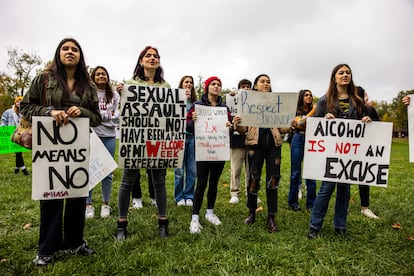Freezing in the face of a threat is normal: Neuroscience counters myths about rape
A scientific article suggests that ‘fear and threat can block cortical neural circuits for action control, leading to involuntary immobility,’ meaning that ‘arguments that blame victims for freezing are thus inappropriate and unjust’

Sudden paralysis. Feeling like you’re outside your body, not being able to control your arms or legs or feet. Freezing, not because of cold but because of fear, in order to survive. Women all over the world who have survived a rape recall this sensation. But the experience is often used in judicial processes to assume that if the victim did not resist, they gave their consent, or to blame them for their lack of reaction, following a common myth that dictates how a victim ought to behave while being assaulted. To counter that idea, Ebani Dhawan and Patrick Haggard, from the Institute of Cognitive Neuroscience at University College London, published an article in Nature Human Behaviour: “Neuroscience evidence counters a rape myth.”
In it, they explain that neuroscience research “suggests fear and threat can block cortical neural circuits for action control, leading to involuntary immobility.” Understanding that brain process “can help improve comprehension” of the crimes and “the realities of victims’ experiences and suffering,” to “counter rape myths,” correct “social errors about gender violence” and “guarantee justice.”
Over email, Haggard says that the article came up while he worked on a project about the importance of willfulness for judicial concepts of responsibility: “We were interested in special situations in which the loss of control over voluntary action can lead to trials of reduced responsibility. We realized that immobility can be involuntary, so that, in appropriate circumstances, society should be prepared to give the same concept of reduced responsibility to the absence of actions as to the presence of actions. And the cases of victims who involuntarily freeze during a rape or a sexual assault are an example.”
In reality, he adds, “women are blamed for freezing, or it is implied that their immobility is not completely involuntary, but indicates consent.” He hopes that focusing on the brain mechanisms can ‘help to counter” the rape myth expressed by the inappropriate question of “why didn’t she fight back?” To understand why a victim did not fight, we must understand how humans operate when threatened: the response, both neural and behavioral, depends “on the severity and proximity of the threat and the perceived capacity to escape,” write Dhawan, a former University College student, and Haggard, a Cognitive Neuroscience professor and researcher at the university.
Fight, flight or freeze
When a threat appears, the brain reacts. The amygdala, a small, bean-sized part of the brain that manages emotional reactions, is the first to receive the stimulus. When the amygdala has processed the emotion, it sends a message to the brain stem’s motor nuclei, which then communicate with the muscles.
Humans and other vertebrates then can have one of several responses. If the threat is mild, they may go into fight or flight responses. “However, sudden, serious threats, like physical restriction, can cause a different kind of response, known as tonic immobility (prolonged immobility in a fixed posture) or collapse immobility (characterized by the loss of muscle tone) in animals.”
The researchers’ hypothesis is that the chain of messages that the different parts of the brain send to react to danger are paralyzed somewhere along the way. That causes “the blockage of neuronal circuits that give voluntary control over the body’s movements.” That process occurs in an instant, as the brain understands that the best way to survive the threat is to stay still. It has been seen to occur in other circumstances, such as airplane pilots who face emergencies while in flight.
Indirect but ‘substantial’ evidence
For now, they explain, it “is still a hypothesis,” because it is not possible to carry out experimental studies on humans facing sudden grave threats like sexual assaults, “for obvious ethical reasons,” Haggard adds. The studies carried out are limited to mild threats, and the evidence is “indirect.” They are limited to victims’ testimonies and studies of animals, with which humans “share a lot of response patterns, which reflect cerebral circuits that have been conserved through evolution for threat processing.” Even so, they add, “the evidence, though indirect, is substantial and convergent.”
The testimonies are abundant in the jurisprudence of many countries. A 1992 case from the United States, which was included in the article, explains that there was proof that the victim had said “no” on several occasions, but no evidence that it would have been effective to resist any more. When she was asked why she had “frozen,” she answered, “I don’t know, I’d said, ‘stop’ and he wasn’t stopping so I [thought] that if he just did what he had to do, then … he would just leave.” In another case included in the study, from Australia in 2018, the victim was asked if she said anything. “No,” she said. Did she do anything? “No. I just —I didn’t do anything.”
In the article, Dhawan and Haggard point out that 70% of women who visit an emergency center after experiencing sexual violence recount having experienced tonic mobility. Until now, they note, neuroscience’s contributions to debates about sexual assault has been “limited.” As a result, myths about rape remain common in the legal sphere. They offer another statistic: “Between September 2021 and September 2022, the police in England and Wales registered more than 70,000 rapes. However, charges were only pressed in 3% of them.”
Neuroscience ‘can contribute to justice’
The researchers argue that the justice system “should recognize that the absence of action can sometimes be voluntary,” that the “obligations and responsibilities in assaults are the fault of the aggressor, not the victim,” and they believe that neuroscience “can contribute to justice.”
They cite a recent study that demonstrated that teaching police officers how the brain mechanism works “reduces the acceptance of rape myths.” It also “improved victims’ willingness to continue with legal procedures,” suggesting that training police could “potentially improve legal and judicial results.” They say that greater awareness “could benefit victims themselves” by reducing their feelings of guilt.
As an example of how to apply the perspective to the law, they talk about Spain’s “only yes is yes” law. Consent, as Haggard emphasizes via email, “is a crucial starting point to organize the relationships between people: it allows us to live without fear of the other and to reach our best potential as rational and willful beings.”
Why victims' stories are sometimes "disjointed"
Researchers Ebani Dhawan and Patrick Haggard point out in the article published in Nature Human Behaviour a "second problem" that occurs in court proceedings with victims who have suffered paralysis: that their accounts "are often disjointed and lack conventional explanatory terms." And "defense attorneys often exploit this fact and direct attention to the victim's inability to articulate and justify her behavior during the assault."
This also implies a blaming of them, "diverting attention from the aggressor's behavior to the allegedly bizarre behavior of the victim." Which, they explain, is not bizarre, but characteristic "of traumatic memories in general," fragmented and incoherent. The law, they say, "already recognizes in guidelines on probative evidence that trauma can affect the ability to remember and explain events, including one's own behavior. But this point often seems to be ignored in legal discussions where immobility is given during an assault."
Sign up for our weekly newsletter to get more English-language news coverage from EL PAÍS USA Edition
Tu suscripción se está usando en otro dispositivo
¿Quieres añadir otro usuario a tu suscripción?
Si continúas leyendo en este dispositivo, no se podrá leer en el otro.
FlechaTu suscripción se está usando en otro dispositivo y solo puedes acceder a EL PAÍS desde un dispositivo a la vez.
Si quieres compartir tu cuenta, cambia tu suscripción a la modalidad Premium, así podrás añadir otro usuario. Cada uno accederá con su propia cuenta de email, lo que os permitirá personalizar vuestra experiencia en EL PAÍS.
¿Tienes una suscripción de empresa? Accede aquí para contratar más cuentas.
En el caso de no saber quién está usando tu cuenta, te recomendamos cambiar tu contraseña aquí.
Si decides continuar compartiendo tu cuenta, este mensaje se mostrará en tu dispositivo y en el de la otra persona que está usando tu cuenta de forma indefinida, afectando a tu experiencia de lectura. Puedes consultar aquí los términos y condiciones de la suscripción digital.
More information
Últimas noticias
Most viewed
- Reinhard Genzel, Nobel laureate in physics: ‘One-minute videos will never give you the truth’
- Oona Chaplin: ‘I told James Cameron that I was living in a treehouse and starting a permaculture project with a friend’
- Pablo Escobar’s hippos: A serious environmental problem, 40 years on
- Charles Dubouloz, mountaineering star, retires at 36 with a farewell tour inspired by Walter Bonatti
- Why we lost the habit of sleeping in two segments and how that changed our sense of time











































